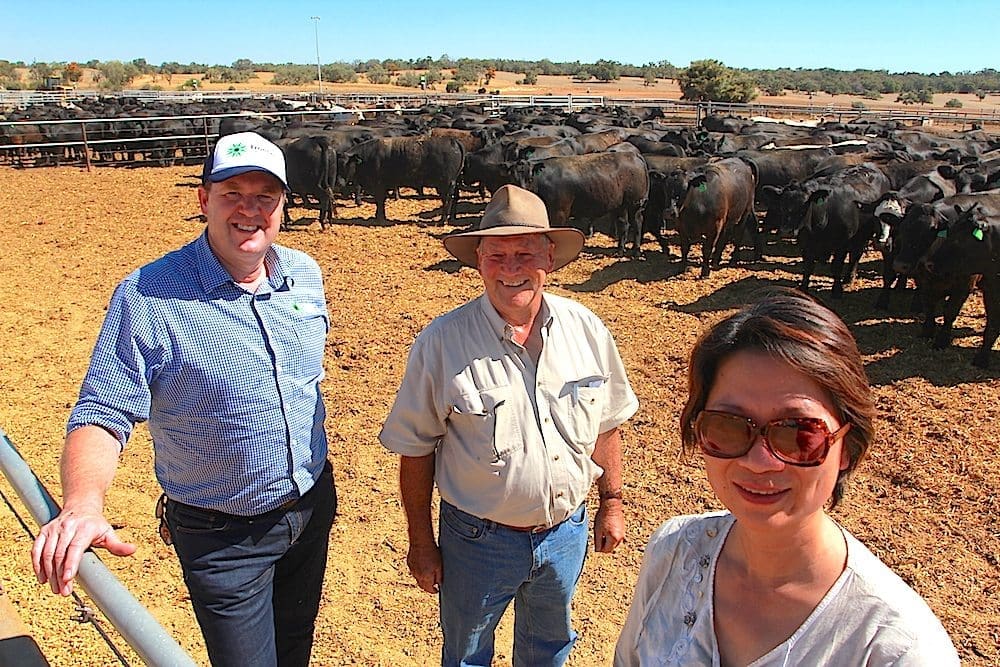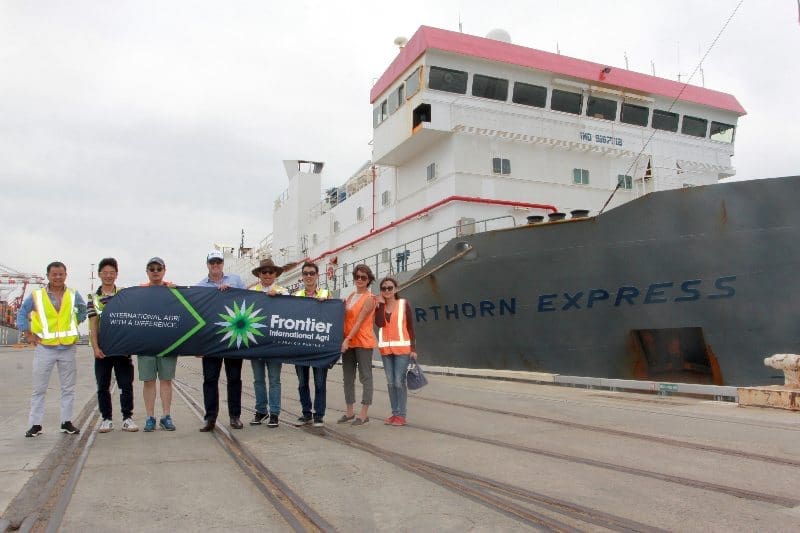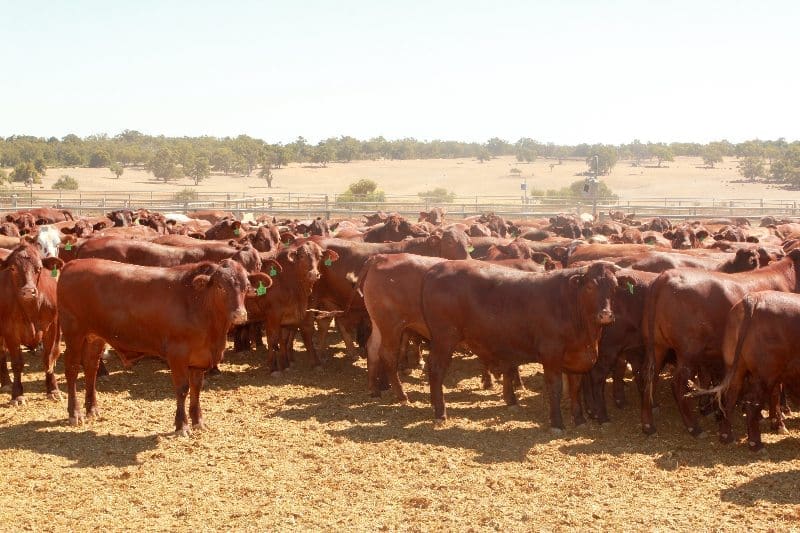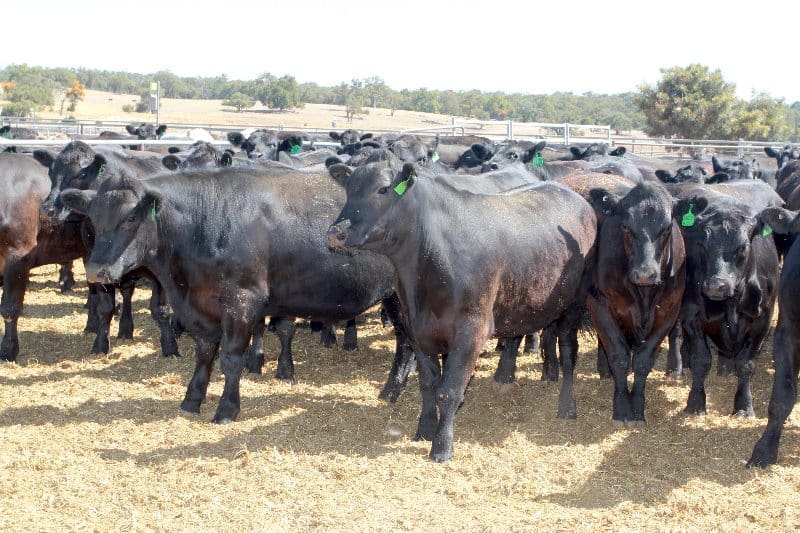
Frontier International sales director Tony Gooden, Geraldton WA veterinarian Bob Nickels and Aus-Sino Trade Alliance chief operations officer Freda Xie with cattle assembled for last night’s shipment.
THE first sea shipment of beef slaughter cattle to China sourced exclusively from Western Australia departed from the Port of Fremantle overnight to supply a brand new, state of the art supply chain developed in Jiangsu Province by a company owned by Chinese-Australian investors.
The consignment, exported by Frontier International for new customer Sino-Aus Dubbo Donghai Agriculture Development Co. Ltd, and coordinated by the supply chain’s main investor, Australian registered company Aus-Sino Trade Alliance Pty Ltd, is the fourth shipment of cattle to be delivered from Australia to China under the emerging slaughter cattle export trade.
The latest shipment is significant on a number of fronts:
- It is the third sea shipment of beef cattle from Australia to China in just over a month, reflecting the transition of new Chinese feedlots and abattoirs built specifically for this trade from construction stage to commercial activity. This delivery is to a new customer which has just completed building a high-end quarantine feedlot and abattoir facility licensed to handle 100,000 imported cattle a year (more on the Aus-Sino Trade Alliance below).
- It is a market-opening shipment for producers in WA, a State well-positioned to supply future demand for live cattle from China. Most of WA is outside the Bluetongue Possible Transmission zone, and many producers in the state are also well-accustomed to supplying cattle to live export markets. The Port of Fremantle is a shorter sailing distance to China’s east coast ports compared to other southern Australian ports.
- The mixture of grassfed and grainfed cattle loaded in this shipment, including not just Angus and Murray Greys but a variety of Santa and Droughtmaster cross cattle from pastoral regions of WA, will help to play an important early role in establishing the suitability of different breeds produced in the State for the Chinese market.
The advanced Sino-Aus abattoir has the capability to supply quarter beef for distribution to wet markets all the way through to retail-ready, individually vacuum packed cuts with a chilled shelf life of maximum 60 days.
Under protocol conditions all imported cattle must be processed within 14 days of arrival in China, which means that within two weeks of delivery Sino Aus will have cold stores brimming with more than 500 tonnes of beef from this shipment to move onto customers.
Aus-Sino Chief Operating Office Freda Xie explained to Beef Central that the beef from this pilot shipment will be distributed to a range of customer channels in Jiangsu Province and the city of Shanghai, including wet markets, wholesale and retail outlets, to determine the most suitable distribution channels for beef from future Australian cattle imports.
Ms Xie said this shipment has been timed to supply beef to the market for the Chinese New Year celebrations in mid-February, a peak period of demand for beef in China.
The average weight of the cattle loaded on this shipment is 530kg, somewhat lighter than the 600kg average of some of the earlier shipments to China. Frontier International sales director Tony Gooden said the lighter average was chosen based on optimal travel and processing performance.
The 1726 slaughter-weight cattle represents a capacity load on the smaller purpose-designed Vroon livestock carrier the MV Shorthorn Express, which departed Fremantle destined for the Chinese port of Lianyungang, north of Shanghai.
Aus-Sino Trade Alliance

Aus-Sino Trade Alliance investors and Frontier International’s Tony Gooden pictured beside the Shorthorn Express at the Port of Fremantle.
Aus-Sino Trade Alliance Pty Ltd was established in 2014 by a group of Chinese -Australian bilingual Australian investors to develop a supply chain for Australian live cattle into China.
The company began the development of the Sino-Aus Dubbo Donghai Agricultural and Livestock Development Pty Ltd quarantine facility and abattoir near the Port of Lianyungang in Jiangsu Province in December 2014.
In February 2015, the Sino-Aus Dubbo Donghai group also established its first outlet store supplying a range of imported Australian beef, red wine, health and other agricultural products in Jiangsu Province. Aus-Sino has plans to expand outlets into other cities in Eastern China through both companies and franchise stores.
Ms Xie said the abattoir has been designed with the highest standards in hygiene, digital control and traceability to be one China’s most advanced beef processing plants, using state of the art processing equipment and meeting Australian and European compliance standards. She said ESCAS had been highly emphasised in the design of the facility to ensure high animal welfare standards.
Aus-Sino Trade Alliance also has plans to invest in Australian agricultural and cattle breeding enterprises.
“Our vision is to create a premium paddock to plate supply chain,” said Sydney-based Ms Xie, a Holistic Medicine Practitioner and University of Technology Sydney (UTS) MBA graduate and teacher.
She said Aus-Sino Trade Alliance is a registered Australian company, which has a 55 percent investment in the Sino-Aus Dubbo Donghai subsidiary that owns the feedlot and abattoir in Jiangsu Province. “So it is Australian investment in China,” she said.
She said the growing cattle import trade will play an important role in filling strong demand for fresh beef in China, and was strongly supported by the Chinese Government.
“Food safety is a very critical issue in China,” she explained, adding that the
Chinese Government was tightening up inspections to stem the flow of illegally smuggled beef into China which was putting food safety at risk.
‘Everybody knows Australia is trustworthy and recognise Australian beef is the best’
“Everybody knows Australia is trustworthy and recognise Australian beef is the best, they like the grassfed, natural and healthy concept of Australian beef.
“It is so famous. It has this very unique sweet fragrance and aroma, there is no other food that can replace it, this taste and aroma will hit your memory and will stay in your memory.
“Because we have very formal channel to import the cattle everyone will have the trust of this beef.”
Ms Xie said the beef from imported cattle will be consumed both in Chinese traditional meals, such as the popular hot pot style of cooking and stir fries, and western style burgers and steaks.
She said the online retail channels are also growing and becoming much bigger in China.
Aus-Sino Trade Alliance placed the order for the cattle for this week’s shipment with Frontier International just 45 days ago, and she credited the exporter’s efforts in being able to assemble and deliver the shipment within that time frame to ensure the beef would be available for the Chinese market for the Chinese New Year festivities in mid-February.
14-day rule counterproductive to China’s quality aspirations
Initial Chinese demand has focused on importing premium quality cattle, but the protocol requirement that cattle must be slaughtered within 14 days of arrival has a negative impact on carcase quality and works against that outcome being achieved.
“The 14 day restriction is problematic because it doesn’t give enough time for the cattle to settle down after the voyage and then be processed,” Frontier International sales director Tony Gooden said.
“The cattle should be rested for one week before they start, or for 10 days ideally.
“The worry is the carcase quality is compromised for that reason.”
Producers urged to be aware of 90-day property residency requirement
Mr Gooden said that as the emerging trade to China develops and increases in volume, cattle producers interested in supplying the trade will have to be aware of a key element of the protocol condition, which requires any cattle sourced for the trade to have spent a minimum of 90 days leading up to export on the same PIC (property identification code).
“It is not a spot buy/sell 15 or 30 days out,” Mr Gooden said.
“Producers are going to have to be prepared to commit out front, and cattle will really need to be contracted 100 days ahead.
“This will be good for those producers who are well organised and prefer a structured program.”
To comply with the protocol conditions cattle had to be physically selected on the property, and fitted with a visual tag that matches the RFID tag, which are then checked with the NLIS database to ensure they have been on the same PIC for at least 90 days before they enter a pre-export quarantine facility.
While cattle breeders can often meet this compliance requirement, it was often harder for backgrounders, feeders and fatteners to comply.
Mr Gooden said there were always challenges developing a new market, however he said all stakeholders involved in last night’s shipment – Aus-Sino, the producers, the quarantine operators at Cullala, China CIQ (quarantine) representatives, DAWR, livestock carriers and the Vroon shipping company – had been fantastic to work with.
“Whilst there are plenty of unique protocol requirements to be met there is only one China market, so we need to work with them to refine aspects of the protocol over time as their confidence in our product and processes increases,” he said of the emerging trade.
Mr Gooden said ensuring the delivery of ESCAS animal welfare requirements was a critical consideration in preparing and planning the shipment.
He said that the closed-loop nature of the Chinese supply chain and the strong Chinese regulation of the trade as well as the in-market work Frontier had done around ESCAS and animal welfare with Aus-Sino had underpinned the delivery of ESCAS and sound animal welfare outcomes.
Where to for the Chinese beef cattle export trade from here?
It seems likely the trade will continue to grow slowly at this point with occasional small shipments gradually becoming more regular over the next year or so as new supply chains find their feet and establish longer term distribution lines for processed beef.
The 14 day rule requiring imported cattle to be slaughtered within two-weeks of arriving in China means it is unlikely importers can handle larger individual volumes and process and sell that beef within that time frame, so smaller shipments and more moderate trade volumes are likely to continue as long as the 14-day rule remains in place.
The sudden burst in activity that triggered three shipments in the past month was at least partially triggered by the desire to have fresh beef available for Chinese New Year in mid-February.
The cost of Australian cattle remains a barrier to higher volume trade at this point, but that factor will be helped by the scheduled removal of a 10 percent tariff on Australian cattle imports into China in January 2019.





HAVE YOUR SAY